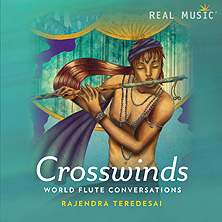 Continuing
to pave the way for world class, state of the art New Age instrumental
music, Real Music released a new CD in 2015 entitled Crosswinds
- World Flute Conversations by Indian flutist Rajendra
Teredesai. The subject of Rajendra’s latest masterpiece is
various flute melodies from around the world, including melodies from
the Middle East, China, India, America and Bali. The windswept qualities
of the flute are quite pronounced in Rajendra’s music. From his
liner notes for the Crosswinds CD, Rajendra explains, ‘Most
tracks on this album have a story to tell. If you listen intently
you will discover that each track has the flute whispering deep mysteries
and singing intriguing tales from the exotic and distant land of India,
China, Tibet, Bali, Arabia and America.” Every song on Crosswinds
has something unique to offer the listener. Of particular note
is the lead off track “The Road To Byblos”, conjuring up
images of Arabian nights and a song which expertly combines Rajendra’s
flute with punctuated synth keyboard effects. The Indian flavored
percussion keeps this track moving at a swift pace. From his original
liner notes, Rajendra states, “This track is about a weary
soldier returning after a long, hard-waged battle to his quaint little
home in the picturesque Byblos, Lebanon.” Many of the tracks
on Crosswinds are deeply meditative sounding, including track
four “Jaisalmer Moon”. The track runs almost ten minutes
and is one of the most sublime tracks on the Crosswinds CD.
Commenting on “Jaisalmer Moon”, Rajendra states, “This
haunting composition depicts the tranquility of the desert and the
deep emotions experienced by the lovers as they sit by the darting
flames of the bonfire in the golden sands, under the starlit sky.”
Perhaps the coolest thing about Crosswinds is its offering
a unique take on 21st century Indian music. Many Western music fans
are familiar with Ravi Shankar and the unique contributions of his
sitar in pop and World Beat music but the flute’s reappearance
in Rajendra’s Real Music albums shines a light on a lesser known
instrument that also has a rich history in the path of Indian music.
Accompanying himself on flute, light percussion and a variety of synth
keyboard programming, Rajendra made a lot of New Age meditation music
fans quite happy with his first two Real Music titles, Divine Dimension
and Path Of The Divine and, with Crosswinds he brings
his artful musicianship to an even higher level. On Crosswinds,
Rajendra Teredesai proves that the flute is a worldwide phenomenon
that truly speaks the language of music. www.RealMusic.com
Continuing
to pave the way for world class, state of the art New Age instrumental
music, Real Music released a new CD in 2015 entitled Crosswinds
- World Flute Conversations by Indian flutist Rajendra
Teredesai. The subject of Rajendra’s latest masterpiece is
various flute melodies from around the world, including melodies from
the Middle East, China, India, America and Bali. The windswept qualities
of the flute are quite pronounced in Rajendra’s music. From his
liner notes for the Crosswinds CD, Rajendra explains, ‘Most
tracks on this album have a story to tell. If you listen intently
you will discover that each track has the flute whispering deep mysteries
and singing intriguing tales from the exotic and distant land of India,
China, Tibet, Bali, Arabia and America.” Every song on Crosswinds
has something unique to offer the listener. Of particular note
is the lead off track “The Road To Byblos”, conjuring up
images of Arabian nights and a song which expertly combines Rajendra’s
flute with punctuated synth keyboard effects. The Indian flavored
percussion keeps this track moving at a swift pace. From his original
liner notes, Rajendra states, “This track is about a weary
soldier returning after a long, hard-waged battle to his quaint little
home in the picturesque Byblos, Lebanon.” Many of the tracks
on Crosswinds are deeply meditative sounding, including track
four “Jaisalmer Moon”. The track runs almost ten minutes
and is one of the most sublime tracks on the Crosswinds CD.
Commenting on “Jaisalmer Moon”, Rajendra states, “This
haunting composition depicts the tranquility of the desert and the
deep emotions experienced by the lovers as they sit by the darting
flames of the bonfire in the golden sands, under the starlit sky.”
Perhaps the coolest thing about Crosswinds is its offering
a unique take on 21st century Indian music. Many Western music fans
are familiar with Ravi Shankar and the unique contributions of his
sitar in pop and World Beat music but the flute’s reappearance
in Rajendra’s Real Music albums shines a light on a lesser known
instrument that also has a rich history in the path of Indian music.
Accompanying himself on flute, light percussion and a variety of synth
keyboard programming, Rajendra made a lot of New Age meditation music
fans quite happy with his first two Real Music titles, Divine Dimension
and Path Of The Divine and, with Crosswinds he brings
his artful musicianship to an even higher level. On Crosswinds,
Rajendra Teredesai proves that the flute is a worldwide phenomenon
that truly speaks the language of music. www.RealMusic.com
mwe3.com presents an interview
with
RAJENDRA TEREDESAI
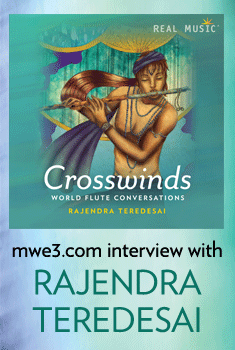 mwe3:
Tell us where you’re from and where you live now and what do
you like best about it? What other cities are you fond of visiting?
mwe3:
Tell us where you’re from and where you live now and what do
you like best about it? What other cities are you fond of visiting?
Rajendra Teredesai:
My family hails from the picturesque coastal Konkan region of the
state of Maharashtra in India. I was born in Mumbai, pursued my basic
education in Mumbai, Shahabad and Pune, and completed my mechanical
engineering degree from Manipal. I have been living in the city of
Pune since 1993. Pune is known here as the “Oxford of the East”.
I love the vibrant scene of education, culture and music here in Pune.
Among the several places that I have visited, I enjoy visiting Goa,
California, where my son resides, Zurich, Salzburg, Vancouver, St.
Victoria, Puerto Rico, Singapore and Barcelona, most.
mwe3: How and when did you first become interested in studying
music? Were the traditions of Indian music ingrained in you at a young
age and when was the Indian flute taught to you and what were your
early studies like?
Rajendra Teredesai:
My grandfather was an ace self taught classical violinist. I became
interested in studying Indian music at the age of 12, beginning to
learn vocal music and tabla (Indian drums) playing from local music
teachers.
Sometime around the age of 14, I picked up the Bansuri (Indian bamboo
flute), as I was immensely captivated by its rich, deeply soothing
and meditative sound, and started learning to play it on my own. Music
being essentially in my genes, I picked up learning to play the flute
rather well. My childhood was spent listening to a lot of good and
diverse music – rich in quality and content. The years spent
exhaustively listening to live concerts, recorded music, and music
played on the radio, had a profound and lasting impact on my evolution
as a musician.
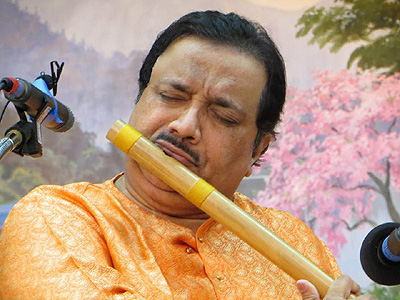 Further,
I spent a couple of years learning from a local flautist Pandit Ram
Bhat, in Manipal / Udupi.
Further,
I spent a couple of years learning from a local flautist Pandit Ram
Bhat, in Manipal / Udupi.
mwe3: Tell us about the Indian music legends you have met.
You studied with Pandit Hariprasad Chaurasia, who is said to be the
most famous of all the great Indian flute legends. And the other name
was Ustad Sayeeduddin Dagar. Most westerners probably don’t know
those names. Were they the most important teachers you had? What other
musicians had a major influence on you?
Rajendra Teredesai:
Even while I was pursuing my engineering studies, I continued practicing
the flute intensely on my own. During this time, I chanced to listen
to the flute of the legendary Pandit Hariprasad Chaurasia, both, in
live concert and on tape. So deeply impressed and overwhelmed was
I by his flute playing, that I made it my life’s raison d
‘etre to study only with this great master.
Later, around 1980, the most momentous period in my life, I had the
good fortune of finally coming under his fold. I learnt from him the
finer aspects of flute playing in the traditional Indian one-on-one
basis guru - student methodology. I spent the most fruitful and exciting
15 years of my life studying with him, listening to his recordings
and attending most of his live concerts, with deep involvement and
dedication.
The journey was indeed difficult and demanding, as I had to squeeze
in time to visit my Guru and practice regularly, even while I worked
as an engineer full time to earn a living. At times, I would spend
practicing vigorously 8-12 hours a day.
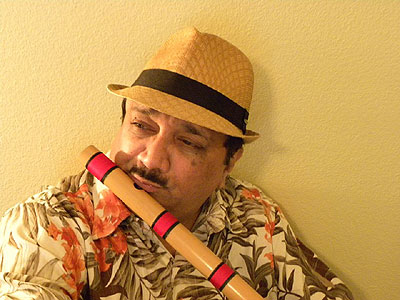 Later,
when I moved to Pune from Mumbai, I spent a couple of years learning
the dhrupad style more deeply with Ustad Sayeeduddin Dagar of the
illustrious Dagar family, who are considered the torch bearers of
the ancient dhrupad tradition of vocal and instrumental music. You
see, I incorporate heavily the dhrupad style of raga developments,
improvisations and aesthetics in my flute playing.
Later,
when I moved to Pune from Mumbai, I spent a couple of years learning
the dhrupad style more deeply with Ustad Sayeeduddin Dagar of the
illustrious Dagar family, who are considered the torch bearers of
the ancient dhrupad tradition of vocal and instrumental music. You
see, I incorporate heavily the dhrupad style of raga developments,
improvisations and aesthetics in my flute playing.
Still later, in my musical journey, Ustad Ali Akbar Khan, the late
California based legendary sarod maestro had offered to teach me after
listening to my flute playing. However, unfortunately, that was not
to be.
Besides the music of my Guruji Pandit Hariprasad Chaurasia, I have
been deeply influenced by the music of the late Ustad Amir Khan Saheb,
Ustad Nazakat Ali and Salamat Ali Khan, the veritable giants of Indian
classical vocal music, and the late Pandit Nikhil Banerjee, the unparalleled
sitar maestro.
So, as such, I would consider them to be the
most important teachers in my pursuit of musical excellence.
mwe3: How would you describe the main differences between Indian
music, which is considered Eastern music, and Western music, which
is more traditional classical, folk and even pop music? Because of
the Beatles and psychedelic music of the 1960s, Indian music now sounds
very normal to our ears. In the past 50 years all types of World music
has entered the Western consciousness.
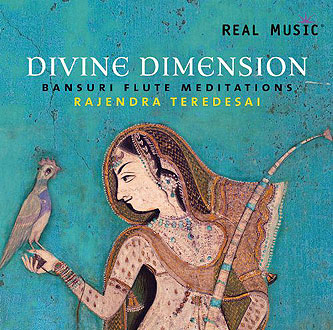 Rajendra
Teredesai: Attempting to elucidate
the differences between Indian and Western music would take me several
hours of elaboration.
Rajendra
Teredesai: Attempting to elucidate
the differences between Indian and Western music would take me several
hours of elaboration.
Indian music, to my mind, has a deeply inherent spiritual quality
to it. It facilitates a direct connect between the musician and divinity.
Indian music purifies the soul and makes the musician one with paramatma.
It is founded on the concept of unpremeditated, spontaneous, structured
and unstructured improvisation. The highly complex nature of sur
(melody) and taal (rhythm) dichotomy in a raga, its development,
interpretation and interaction is too intricate and vast in scope
to discuss here.
Suffice to say that the repository of Indian classical ragas is so
stupendously vast and rich in resource and content, that mastering
and interpreting the ragas with utter perfection may be treated as
an unending endeavor involving several lifetimes.
A seasoned classical musician is able to improvise and play a raga
impromptu for as much as a couple of hours without making it sound
monotonous or repetitive, even while holding his audience in spellbound
rapture. No notes or sheet music are referred to by the performing
musicians. No two concerts are exactly the same. In a live concert
scenario, no two musical moments may be exactly the same in terms
of performance and aural experience.
For me, Western music is equally fascinating, particularly jazz.
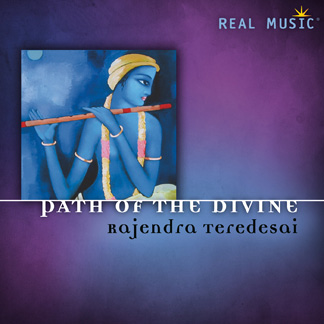 mwe3:
How many albums have you recorded and released in India and other
countries? What about session work in India and also have you done
film soundtracks? The influence of Bollywood is acclaimed worldwide
these days. What other artists have you recorded with including guitarists
and are there other Indian musicians can you recommend us to?
mwe3:
How many albums have you recorded and released in India and other
countries? What about session work in India and also have you done
film soundtracks? The influence of Bollywood is acclaimed worldwide
these days. What other artists have you recorded with including guitarists
and are there other Indian musicians can you recommend us to?
Rajendra Teredesai:
Besides recording and releasing nine albums internationally, some
of which have flute tracks played by me, I am in the process of releasing
another three international albums during 2015. Besides these, I have
recorded and released eight albums in India.
No, I haven’t done a film soundtrack so far, but, would certainly
love to do it for an appropriate film, something similar to Siddhartha,
Seven Years In Tibet and Samsara.
My approach to music is eclectic and deeply spiritual. I used to enjoy
the music of the golden era of Indian movies of the 1950s, ‘60s
and ‘70s.
Sadly, the melodic and emotional content is quite lacking in Bollywood
music today, So I don’t subscribe to it, nor do I have any plans
playing for Bollywood films.
As regards my international collaborations, I have recorded several
albums with Lucjan Wesolowski from Poland, Stephen Bellm from the
US, and Blue Monk from Malaysia.
I would certainly love to work and record with musicians like Peter
Kater, R. Carlos Nakai, Richard Clayderman, John McLaughlin and Yo-Yo
Ma.
There are several talented Indian musicians in different genres of
music, hence, naming any single one is quite difficult.
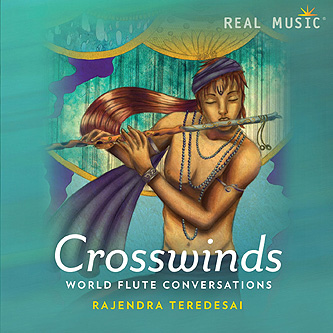 mwe3:
Tell us about your 2015 CD on Real Music called Crosswinds, which
is subtitled “World Flute Conversations”. When did you get
the idea to record and release a CD of flute music from all the world
over and how did you meet up with Terrence and Real Music? This is
your third release on Real Music.
mwe3:
Tell us about your 2015 CD on Real Music called Crosswinds, which
is subtitled “World Flute Conversations”. When did you get
the idea to record and release a CD of flute music from all the world
over and how did you meet up with Terrence and Real Music? This is
your third release on Real Music.
Rajendra Teredesai:
Due to my fascination with woodwind instruments, I do play several
flutes from across the world. After recording and releasing Divine
Dimension and Path Of The Divine, I had presented the idea
of doing an album featuring world flutes to Terence Yallop at Real
Music in early 2014. He loved it.
It took me close to six months working on composing and recording
the tracks of Crosswinds with Blue Monk. Terence loved the
final result. However, it was a good six months of waiting before
it was scheduled for release in April 2015.
I had recorded three albums for a relatively unknown US based music
label during 2011 – 2012. Unfortunately, the music company owner
/ producer died abruptly. My dreams of getting this music released
were shattered. However, just when all hope was lost, Terence came
along and signed me up for Real Music. Terence was truly a Godsend.
I respect Terence a lot. He has a fine aesthetic sense and a marvelous
ear for good New Age and meditational music. Hence, I believe my association
with Real Music has been very rewarding and fruitful. And I look forward
to releasing many more albums with them in future.
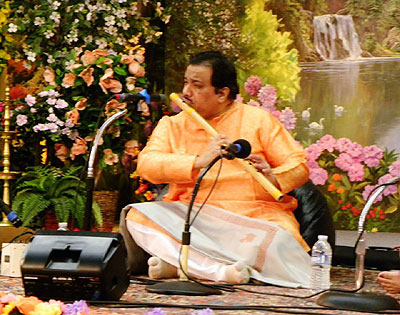 mwe3:
Tell us about your recording studio and how many instruments did you
use to record the Crosswinds CD? There’s also a range
of sounds on the CD and you’re credited as playing everything.
It’s a great idea to blend Indian music with different instruments
including electronica and programmed percussion.
mwe3:
Tell us about your recording studio and how many instruments did you
use to record the Crosswinds CD? There’s also a range
of sounds on the CD and you’re credited as playing everything.
It’s a great idea to blend Indian music with different instruments
including electronica and programmed percussion.
Rajendra Teredesai:
I work from my recording studio set up at home, comprising of a host
of Tascam, Korg and Zoom multi track digital recorders - mixers, Yamaha
and Korg synthesizers, an array of high quality microphones, Yamaha
monitors and recording / editing / mastering software. All the flutes
in Crosswinds were, of course, played by me. I have worked
closely with my good friend Blue Monk to get just the right instruments,
melodic arrangements and percussion for all the tracks. It involved
lot of active coordination and hard work. Moreover, each track had
a story to tell. Hence, several demos had to be scored for each track,
and fine tuned, till the exact soundscape was captured and delivered
in the tracks.
Instruments as diverse as the Tibetan meditation bowl, the Arabian
darbuka, oud, Balinese gamelan, eagle bone whistles, Chinese erhu
and harp, besides several others, have been judiciously deployed for
added effect.
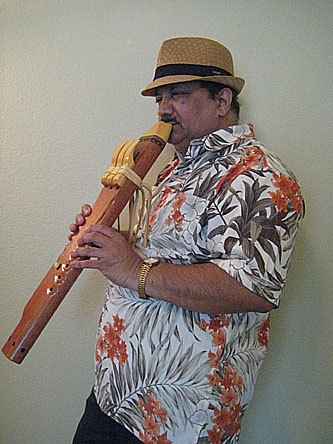 Blue
Monk is an extremely gifted composer / musician. We have a fine rapport
and an excellent understanding, whereby we are able to translate our
creative ideas into tracks composed and arranged to the highest standards
of musical excellence.
Blue
Monk is an extremely gifted composer / musician. We have a fine rapport
and an excellent understanding, whereby we are able to translate our
creative ideas into tracks composed and arranged to the highest standards
of musical excellence.
mwe3: Tell the readers about your flutes, the Bansuri. Which
flutes did you use to make the Crosswinds CD and what are some
of your favorite flutes?
Rajendra Teredesai:
I have over one hundred different flutes, ranging from the Bansuri,
Native American flutes, Arabian flutes, Balinese suling, South American
quenas and pan flutes, Chinese dizi etc... Some of these are specially
crafted for my specific use.
I have used different bansuris, the shankh bansuri (deep bass flute),
the Arabian flute, the Chinese flute, the Balinese flute and the Native
American flutes for the different tracks of the Crosswinds
CD.
Some of my favorite flutes are the Native American Flutes crafted
by the expert flute maker Dana Ross. These are truly outstanding for
their innovative design, sheer tonal quality and range.
mwe3: What are the main differences between Indian flutes and
flutes and other instruments from other countries? How many different
flutes have you played over the years?
Rajendra Teredesai:
The main difference is, of course, the tuning. Flutes are tuned differently
depending upon which country / culture they belong to.
 Another
difference is the material of the body... some flutes like the bansuri,
the shakuhachi and the suling are made from specially cultivated bamboo,
others like the Native American flutes and the quenas are made from
different types of wood, yet others like the Arabian kawala and nay
are made from special cane or reed.
Another
difference is the material of the body... some flutes like the bansuri,
the shakuhachi and the suling are made from specially cultivated bamboo,
others like the Native American flutes and the quenas are made from
different types of wood, yet others like the Arabian kawala and nay
are made from special cane or reed.
Yet another difference is the blowing and playing technique and the
design of the mouthpiece and embouchure, and whether the flute is
side-blown or end-blown.
mwe3: Are you also involved in other activities in other areas
as well? What about other interests and how do you relax and escape
the pressure of the world?
Rajendra Teredesai:
As a performing and recording musician, much of my time everyday is
consumed in composing, playing and teaching music. I find little time
for much else.
However I do spend my leisure listening to lot of music, reading and
watching movies. I particularly enjoy spending the weekend at my farmhouse
on the outskirts of Pune, relaxing in the lap of nature.
mwe3: What other plans do you have for your music during 2015
and 2016, including writing new music, playing live concerts and recording?
 Rajendra
Teredesai: I am presently working
on five albums planned for release during 2015 and 2016. Out of these,
I have already completed composing and recording for four albums.
Rajendra
Teredesai: I am presently working
on five albums planned for release during 2015 and 2016. Out of these,
I have already completed composing and recording for four albums.
Besides, I am also contemplating doing a followup album on Crosswinds,
featuring again, world flutes.
I do hope and pray earnestly that I can continue playing the flute
till my last breath.
Thanks to Rajendra Teredesai @ www.rajendrateredesai.com



